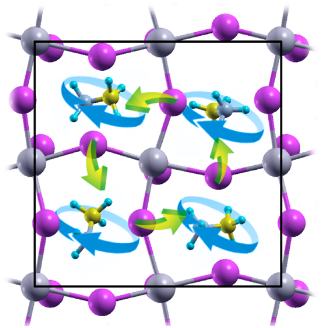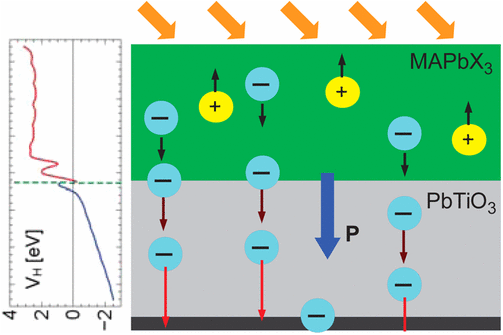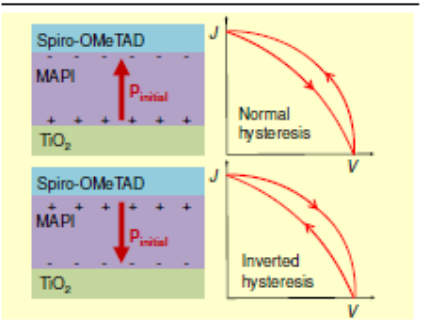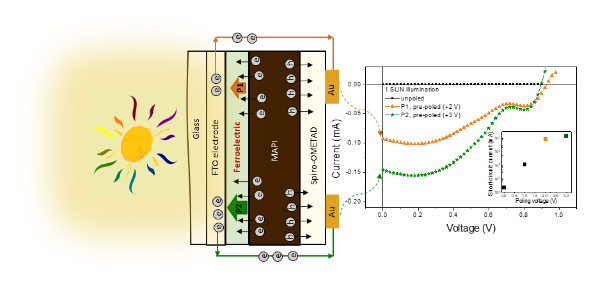Publications
1) Collective Behavior of Molecular Dipoles in CH3NH3PbI3
C. Goehry, G. A. Nemnes and A. Manolescu; J. Phys. Chem. C 2015, 119, 19674−19680
DOI: http://dx.doi.org/10.1021/acs.jpcc.5b05823
ABSTRACT: Using ab initio molecular dynamics, we report a detailed exploration of the thermal motion occurring in perovskite crystals of the formula CH3NH3PbI3. We exploit the data generated to obtain estimates of the rotational relaxation time of the cation CH3NH3+. We examine the tetragonal and cubic phases, as both may be present under operational conditions. Influenced by each other, and by the tilting of PbI6 octahedra, cations undergo collective motion as their contribution to polarization does not vanish. We thereby qualitatively describe the modus operandi of formation of microscopic ferroelectric domains.

2) Optimization of halide perovskite solar cells based on nanocolumnar ZnO
Adela Nicolaev, T.L.Mitran, Sorin Iftimie, G.A.Nemnes; Solar Energy Materials and SolarCells (2015)
DOI: http://dx.doi.org/10.1016/j.solmat.2015.10.023
ABSTRACT: Halide perovskite solar cells based on nanocolumnar ZnO are considered alternative candidates to the more establishedTiO2 based devices. Replacing the scaffold oxide layer by ZnO has the benefit of a larger electron mobility and lower processing temperatures, still reaching power conversion efficiencies (PCEs) of over 15%. The perovskite layer stability and improving the PCE are currently two major issues under investigation. Regarding the latter, the presence of an interfacial layer of Al-doped ZnO (AZO) gives an enhanced power out put, as it was recently reported. Using density functional theory calculations we discuss the band alignment at the ZnO(AZO)-halide perovskite interface, indicating one possible source for the enhanced PCE.
3) Band alignment and charge transfer in rutile-TiO2/CH3NH3PbI3xClx interfaces
G. A. Nemnes, C. Goehry, T. L. Mitran, Adela Nicolaev, L. Ion, S. Antohe,
N. Plugaru and A. Manolescu; Phys. Chem. Chem. Phys., 2015, 17, 30417–30423
DOI: http://dx.doi.org/10.1039/c5cp05466d
ABSTRACT: Rutile-TiO2/hybrid halide perovskite CH3NH3PbI3xClx interfaces are investigated by ab initio density functional theory calculations. The role of chlorine in achieving enhanced solar cell power conversion efficiencies is in the focus of recent studies, which point to increased carrier mobilities, reduced
recombination rates, a driven morphology evolution of the perovskite layer and improved carrier transport across the interface. As it was recently established that chlorine is preferentially localized in the vicinity of the interface and not in the bulk of the perovskite layer, we analyze the changes introduced in the electronic properties by varying the chlorine concentration near the interface. In particular, we discuss the effects introduced in the electronic band structure and show the role of chlorine in the enhanced electron injection into the rutile-TiO2 layer. Taking into account these implications, we discuss the conditions for optimizing the solar cell efficiency in terms of interfacial chlorine concentration.
4) Charge localization effects and transport in dendritic nanostructuresfor photovoltaic applications
G.A. Nemnes, Sorina Iftimie, Applied Surface Science, 2015 352,158–162
DOI: http://dx.doi.org/10.1016/j.apsusc.2015.02.124
ABSTRACT: Charge localization effects and transport properties in dendritic interfaces are investigated in the frame-work of a coherent scattering formalism. Due to the large surface area, tree shaped interfaces enhancethe overall efficiency of bulk heterojunction photovoltaic applications. The charge localization effectsare analyzed for different tree shapes, band offset potentials and in the context of varying the thicknessof the tree branches. Two types of localization are pointed out – on the tree branches or inbetween.The transfer characteristics are influenced by the band offsets and the energy of the charged particles.A detailed statistical analysis shows the correlation between the average transmission function and thesurface area of the dendritic interface. The current study provides a framework for the characterizationand optimization of dendritic interfaces.
5) Transparent boundary conditions for time-dependent electron transport in the R-matrix method with applications to nanostructured interfaces
G.A. Nemnes, Alexandra Palici, A. Manolescu, Computer Physics Communications, 2016, 208, 109–116
DOI: http://dx.doi.org/10.1016/j.cpc.2016.08.007
ABSTRACT: Transparent boundary conditions for the time-dependent Schrödinger equation are implemented using the R-matrix method. The employed scattering formalism is suitable for describing open quantum systems and provides the framework for the time-dependent coherent transport. Transmission and reflection of wave functions at the edges of a finite quantum system are essential for an accurate and efficient description of the time-dependent processes on large time scales. We detail the computational method and point out the numerical advantages stemming from the open system approach based on the R-matrix formalism. The approach is used here to describe time-dependent transport across nanostructured interfaces relevant for photovoltaic applications.
6) Iodine Migration and Degradation of Perovskite Solar Cells Enhanced by Metallic Electrodes
C. Besleaga, L.E. Abramiuc,V. Stancu, A.G. Tomulescu, M. Sima,L. Trinca, N. Plugaru, L. Pintilie, G.A. Nemnes, M. Iliescu, H.G. Svavarsson, A. Manolescu, I. Pintilie, J. Phys. Chem. Lett. 2016, 7, 5168−5175
DOI: http://dx.doi.org/10.1021/acs.jpclett.6b02375
ABSTRACT: We monitored the evolution in time of pinhole-free structures based on TO/TiO2/CH3NH3PbI2.6Cl0.4 layers, with and without spiro-OMeTAD and counter electrodes (Ag, Mo/Ag, and Au), aged at 24 °C in a dark nitrogen atmosphere. In the absence of electrodes, no degradation occurs. While devices with Au show only a 10% drop in power conversion efficiency, remaining stable after a further overheating at 70 °C, >90% is lost when using Ag, with the process being slower for Mo/Ag. We demonstrate that iodine is dislocated by the electric field between the electrodes, and this is an intrinsic cause for electromigration of I− from the perovskite until it reaches the anode. The iodine exhaustion in the perovskite layer is produced when using Ag electrodes, and AgI is formed. We hypothesize that in the presence of Au the iodine migration is limited due to the buildup of I− negative space charge accumulated at the perovskite−OMeTAD interface.

7) Dynamic electrical behavior of halide perovskite based solar cells
G.A. Nemnes, C. Besleaga, A.G. Tomulescu, I. Pintilie, L. Pintilie, K. Torfason, A. Manolescu, Solar EnergyMaterials&SolarCells 2017, 159
,197–203
DOI: http://dx.doi.org/10.1016/j.solmat.2016.09.012
ABSTRACT: A dynamic electrical model is introduced to investigate the hysteretic effects in the J-V characteristics of perovskite based solar cells. By making a simple ansatz for the polarization relaxation, our model is able to reproduce qualitatively and quantitatively detailed features of measured J-V characteristics. Pre-poling effects are discussed, pointing out the differences between initially over- and under-polarized samples. In particular, the presence of the current overshoot observed in the reverse characteristics is correlated with the solar cell pre-conditioning. Furthermore, the dynamic hysteresis is analyzed with respect to changing the bias scan rate, the obtained results being consistent with experimentally reported data: the hys- teresis amplitude is maximum at intermediate scan rates, while at very slow and very fast ones it be- comes negligible. The effects induced by different relaxation time scales are assessed. The proposed dynamic electrical model offers a comprehensive view of the solar cell operation, being a practical tool for future calibration of tentative microscopic descriptions.
8) Single-crystal TiO2 nanowires by seed assisted thermal oxidation of Ti foil: synthesis and photocatalytic properties
E. Arcadipane, R. Sanz, G. Amiard, S. Boninelli, G. Impellizzeri, V. Privitera, J. Bonkerud, C.
Bhoodoo, L. Vines, B. G. Svensson and L. Romano, RSC ADVANCES Volume: 6 Issue: 60 Pages: 55490-55498 Published: 2016 DOI: 10.1039/c6ra09088e, with correction RSC ADVANCES Volume: 7 Issue: 19 Pages: 11222-11222, Published: 2017
DOI: https://doi.org/10.1039/C6RA09088E
DOI: http://dx.doi.org/10.1039/c7ra90019h
ABSTRACT:
TiO2 nanowires (NWs) can improve the advantageous photocatalytic properties of TiO2 by increasing the active surface area. Here we investigate the synthesis of TiO2 NWs by thermal oxidation, studying the role of temperature, annealing time, and gas flow rates. The optimal thermal growth condition was found to be 800°C, 4h in a mixed gas flow of Ar and O2. Morphological and structural characterizations, carried out by scanning and transmission electron microscopy, and Xray diffraction, indicated a TiO2 rutile monocrystalline structure of the nanowires. An in situ thermal growth analysis was performed by means of an environmental electron microscope, providing additional insights on the TiO2 NWs growth dynamics. The photocatalytic properties were studied by using the degradation rate of Methilene Blue under UV light. TiO2 NWs revealed a 70% improvement of the degradation rate compared to a reference TiO2 bulk sample. Moreover, NWs were additionally annealed in forming gas (5%H2 in N2) in order to promote the formation of oxygen vacancies and an increase of the carrier density. Indeed, the photocatalytic activity of the NWs treated in forming gas, was 3 times higher than the one of the reference TiO2 bulk sample. The photonic efficiency and the quantum efficiency, also showed an increase versus bulk TiO2 of about 20% in the presence of NWs, and of about 100% with the forming gas annealing. Moreover, this increase in the photocatalytic activity after the forming gas annealing correlates also with the disappearance of a deep level recombination center as observed by deep level transient spectroscopy.
9) Atomistic Simulations of Methylammonium Lead Halide Layers on PbTiO3 (001) Surfaces
N. Plugaru, G. A. Nemnes, L.Filip, I. Pintilie, L. Pintilie, K. T. Butler and A. Manolescu, J. Phys. Chem. C, 2017, 121 (17), pp 9096–9109;
Publication Date (Web): April 10, 2017
DOI: http://dx.doi.org/10.1021/acs.jpcc.7b00399
ABSTRACT:

The substantial increase in the power conversion efficiency of hybrid perovskite solar cells, to date reaching more than 20% in the laboratory, has strongly motivated research on this class of organic–inorganic materials and related devices, particularly based on CH3NH3PbI3–xXx/TiO2 heterostructures (X = Cl,Br). Taking under consideration that a ferroelectric substrate may act as an efficient electron transporter, positively influencing charge collection across the interface and allowing the tuning of the halide perovskite (HP) - ferroelectric junction, we performed extensive density functional theory calculations on CH3NH3PbI3–xClx layers deposited on tetragonal PbTiO3 (PTO) (001) surfaces, to study their structural and electronic properties. The main findings of this study are as follows. (i) A ferroelectric polarization pointing from the PTO/HP interface to the PTO is favorable for the photogenerated electrons transfer across the interface and their transport to the collecting electrode. (ii) The PTO internal electric field leads to a position dependent energy levels diagram. (iii) The HP gap may be tuned by chlorine concentration at the interface, as well as the by the surface terminations of PbTiO3 and hybrid perovskite layers. (iv) The presence of the PTO ferroelectric surface is likely to have just a slight orientational effect on the (CH3NH3)+ dipoles.
10) Lead acetate film as precursor for two-step deposition of CH3NH3PbI3
M. Sima, E. Vasile and Ma. Sima, Mater. Res. Bull. 89, 89-96, Published: MAY 2017
DOI: http://dx.doi.org/10.1016/j.materresbull.2017.01.031
ABSTRACT:
This paper relates to a method for the preparation of lead acetate film and its use as precursor for twostep solution deposition of CH3NH3PbI3 perovskite film. For the preparation of perovskite film, lead acetate was used both in the form of trihydrate and dehydrated. The effects of lead acetate trihydrate dehydration on the structure of the resulted perovskite films were studied. The prepared perovskite films which consist of cuboid grains, show high surface coverage both on FTO and TiO2 substrates. XRD measurements have not revealed the presence of the PbI2 contaminant in perovskite film. Solvent vapor annealing method was employed to prepare perovskite film that contains lead iodide. Using impedance spectroscopy measurements, we further evaluated the influence of the prepared perovskite films on the performance of the photovoltaic devices.
11) Normal and inverted hysteresis in perovskite solar cells
G. A. Nemnes, C. Besleaga, V. Stancu, L. N. Leonat, L. Pintilie, K. Torfason, M. Ilkov, A. Manolescu, I. Pintilie, J. Phys. Chem. C, 2017, 121 (21), 11207–11214, Publication Date (Web): May 11, 2017
DOI: http://dx.doi.org/10.1021/acs.jpcc.7b04248
ABSTRACT:

Hysteretic effects are investigated in perovskite solar cells in the standard FTO/TiO2/CH3NH3PbI3-xClx/spiro-OMeTAD/Au configuration. We report normal (NH) and inverted hysteresis (IH) in the J-V characteristics occurring for the same device structure, the behavior strictly depending on the pre-poling bias. NH typically appears at pre-poling biases larger than the open circuit bias, while pronounced IH occurs for negative bias pre-poling. The transition from NH to IH is marked by a intermediate mixed hysteresis behavior characterized by a crossing point in the J-V characteristics. The measured J-V characteristics are explained quantitatively by the dynamic electrical model (DEM). Furthermore, the influence of the bias scan rate on the NH/IH hysteresis is discussed based on the time evolution of the ionic polarization charge. Introducing a three step measurement protocol, which includes stabilization, pre-poling and measurement, we put forward the difficulties and possible solutions for a correct PCE evaluation.
12) Properties of perovskite ferroelectrics deposited on F doped SnO2 electrodes and the prospect of their integration into perovskite solar cells
I. Pintilie, V. Stancu, A. Tomulescu, R. Radu, C. Besleaga Stan, L. Trinca, L. Pintilie, Materials & Design(2017)
DOI: http://dx.doi.org/10.1016/j.matdes.2017.09.013
ABSTRACT:

The integration of ferroelectrics in perovskite solar cells is proposed as possible way to enhance
charge collection efficiency. First results on solar cell manufactured with PbTiO3 (PTO) instead of TiO2 has shown negligible values for the power conversion efficiency (PCE). This is explained by the high serial resistance of sol-gel deposited PTO on F:SnO2 electrodes (FTO). Although PTO layer has remnant polarization of 22 µC/cm2, the high potential barrier (0.25±0.05 eV) at the FTO/PTO interface and low carrier mobility (10-8 cm2V-1s-1) compared to TiO2 leads to high serial resistance. Better results were obtained with thinner PTO layers grown by pulsed laser deposition, with PCE values up to 0.6 %. Further enhancement was obtained by replacing PTO with BaTiO3 (BTO), with PCE value reaching about 0.8 % after poling the cell with +3 V. The most important finding was that the magnitude of the short circuit current increases with the amplitude of the poling voltage while the value of the open-circuit voltage remains about the same, around 0.9 V. This is explained through more efficient collection of the charges generated under illumination in the absorber layer due to the polarization that is present in the ferroelectric film.
13) Influence of annealing atmosphere on formation of electrically-active defects in rutile TiO2
C. Zimmermann, J. Bonkerud, F. Herklotz, T.N. Sky, A. Hupfer, E. Monakhov, B.G. Svensson, L.Vines, JOURNAL OF APPLIED PHYSICS 123, 16, 161572, 2018
DOI: http://dx.doi.org/10.1063/1.5011136
ABSTRACT:
Electronic states in the upper part of the bandgap of reduced and/or hydrogenated n-type rutile TiO2 single crystals have been studied by means of thermal admittance and deep-level transient spectroscopy measurements. The studies were performed at sample temperatures between 28 and 300 K. The results reveal limited charge carrier freeze-out even at 28K and evidence the existence of dominant shallow donors with ionization energies below 25 meV. Interstitial atomic hydrogen is considered to be a major contributor to these shallow donors, substantiated by infrared absorption measurements. Three defect energy levels with positions of about 70 meV, 95 meV, and 120 meV below the conduction band edge occur in all the studied samples, irrespective of the sample production batch and the post-growth heat treatment used. The origin of these levels is discussed in terms of electron polarons, intrinsic point defects, and/or common residual impurities, where especially interstitial titanium atoms, oxygen vacancies, and complexes involving Al atoms appear as likely candidates. In contrast, no common deep-level defect, exhibiting a charge state transition in the 200-700 meV range below the conduction band edge, is found in different samples. This may possibly indicate a strong influence on deep-level defects by the post-growth heat treatments employed. Published by AIP Publishing.
14) Hydrogen motion in rutile TiO2
A.J. Hupfer, E.V. Monakhov, B.G. Svensson, I. Chaplygin, E.V. Lavrov, SCIENTIFIC REPORTS 7 Article Number: 17065, 2017
DOI: http://dx.doi.org/10.1038/s41598-017-16660-3
ABSTRACT:
Uniaxial-stress experiments have been performed for the 3287- and 2445-cm(-1) local vibrational modes assigned to the positive charge state of interstitial hydrogen (H-i(+)) and deuterium (D-i(+)), respectively, occurring in mono-crystalline rutile TiO2. The onset of the defect alignment under the stress applied perpendicular to the [001] axis is detected at 165 K (185 K), which corresponds to the activation energy of 0.53 eV (0.58 eV) for interstitial hydrogen (deuterium). Based on these findings the diffusion constants of H-i(+) and D-i(+) along the [001] axis of TiO2 are determined. The experimental data are complemented by density-functional theory calculations and compared with the earlier results on the diffusion of H-i(+)/D-i(+) at elevated temperatures up to 700 degrees C. It is found that the activation energy value deduced from our low-temperature stress measurements yields a very good agreement with the high-temperature data, covering a dynamic range of 12 orders of magnitude.
